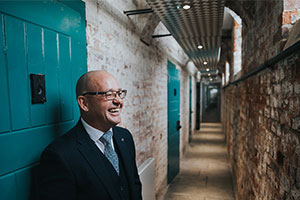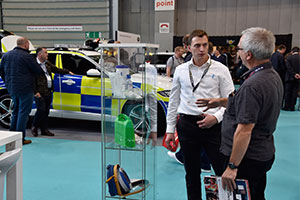
Waterside Press are giving away a copy of Confessions of a Prison Chaplain by Mary Brown and Opening the Doors: A Prison Chaplain’s Life on the Inside by Paul Gill in a prize worth over £30. Here, Bryan Gibson writes about the titles which follow the authors' work…
A stereotype image of the prison chaplain is perhaps of a ‘meddling do-gooder’ who can embarrass hardened inmates by talking to them as if they are children. Someone ‘born yesterday’ who is distant, easy to con, wears a ‘dog-collar’ or beads, is not from the establishment concerned, and who pops up now and again with a kindly smile on his face (unlike the guards).
But modern chaplains are not like that – and they can be a real ‘safety valve’ and outside link. Nowadays they are likely to be from one of a number of faiths (or even none), part of a team – including women – dedicated to a non-judgmental approach. They are a central component in diffusing tensions, reducing re-offending and helping offenders to change (or rescue) heart, mind and even life. If this sounds pompous it’s the nature of the work!

Tim Tate is an author, investigative journalist and filmmaker who worker with the late Ray Wyre – a pioneer in treatment of child sex offenders. Here, Tim describes how Ray’s work challenged the lack of rehabilitation options for paedophiles and asks if the current system is doing enough to protect children from abuse…
For someone whose work would become so influential, Ray Wyre’s introduction to sex offenders was surprisingly accidental.
In 1981, three years after joining the Probation Service, he was transferred to Albany, the high security facility on the Isle of Wight: here, by chance, he was assigned to the E Wing, which then housed 36 sex offenders in segregation from the rest of the prison’s population.

Assaults and self-harm incidents in prisons in England and Wales have reached a record high, according to the government’s Safety in Custody quarterly bulletin.
Over the last year, there have been 325 deaths in prison custody - up 8% on the previous year. Out of those, 87 were self-inflicted deaths. A huge 9,485 assaults were recorded against staff, up 27%, and prisoner-on-prisoner assaults reached 23,448.
The report also stated that nearly 50,000 self-harm incidents took place over the last year, up by 20%.
Commenting on the publication of today's safety in custody statistics, Peter Dawson, director of the Prison Reform Trust, said: “Despite the unrelenting effort of many in the system, all of these indicators show that there is no end in sight to the catastrophe that has engulfed many of our prisons.

The Custodial Review spoke to Alex Viccars, Senior Research Officer at The Forward Trust, about the work the organising does to tackle substance addiction in prisons – including female prison HMP Send…
The Forward Trust (formerly RAPt) has been empowering people to break the cycles of addiction and crime and move forward with their lives for over 25 years. We currently deliver substance misuse services in 18 UK prisons and two community services, reaching over 15,000 service users each year. Peer role modelling and lived experience of crime and addiction sit at the heart of our treatment approach – with 1 peer supporter employed for every 4 staff members, and 30% of our workforce are in recovery from addiction.

It has arguably never been more difficult to find good temp workers thanks to a frustratingly inefficient and expensive recruitment process. However, help is at hand, says TempRocket’s Andrew Johnston…
It’s no secret that finding the right people to add to your team cannot only be a very tough task, but also annoyingly time consuming and expensive, whether you’re recruiting for the police, prison service or customer and immigration services. And this is especially the case when it comes to tracking down good temporary workers, because the process on this side of the recruitment sector is particularly inefficient.

Gethin Jones is an inspirational speaker, advising prison governors and staff on how to really make an impact on prisoners’ lives. And he should know, as he turned his life around after spending time inside for a string of crimes or, as he puts it, having “a 20-year relationship with the criminal justice system”.
Since making the decision to turn his life around at the age of 34, Gethin has worked for Portsmouth City Council’s public health department and credits a number of prison staff members who believed in him – as they fuelled his need to push himself out of a cell.
Editor Victoria Galligan spoke to Gethin about the work he does now with prison staff and also with young offenders. He describes the impetus to change, his own final straw moment, as a time where he had “hit rock bottom, and was bouncing on the bottom of the floor”. And his experience is exactly what puts Gethin in a position perfect for reflection on the running of a prison – clients value his advice so much because of his past.

With a plethora of events coming up for custodial services, 999 workers and those involved in criminal justice, we offer a round-up including highlights of each. We will be attending some of the events and look forward to meeting you there.
Please contact us with any future events which you would like to be added to our diary dates – email editorial@euromediaal.com.
• Police Federation: National Custody Seminar
September 11 & 12, De Vere Hotel, Daventry, Northamptonshire
The Police Federation of England and Wales will host its annual Custody Seminar in September, and a number of speakers have been confirmed to date, with pre-charge bail and mental health being two of the topics on the agenda.

Each year there are nearly 6000 reported incidents of assaults on prison officers within English and Welsh prisons, 700 of which resulted in serious injury last year. With figures of incidents rising by a third in 2016, the protection of staff and prisoners is high on the government’s agenda.
Statistics from the Ministry of Justice indicate that prisoner-on-prisoner assaults have, too, risen by a third in the last year, prompting comments from past Justice Secretary Liz Truss around prison safety and reform, and from the Prison Reform Trust who printed that “people in prison, prisoners and staff, are less safe than they have been at any other point since records began.”

Niall Kelly, CIO of Netwatch Group, discusses the relationship between prison standards and comprehensive video surveillance…
The capabilities of modern video surveillance technology are staggering. Across the prison estate, they are enabling occupational capacity with unprecedented standards of surveillance that go hand in hand with good governance and help to achieve the highest standards of control and safety.
Comprehensive monitoring makes the most of valuable human resources and mitigates the ever-present risks presented by overcrowding, violence, drug use and accusations of misconduct. Huge advances in digital signalling, video analytics, cloud processing, AI and deep learning are combining to enable proper stewardship of far-flung, secure areas.

As a partner of the Custodial Facilities Forum, The Custodial Review are pleased to announce that you have chance to present at the event – where secure estates and facilities of the future will be the focus.
The CFF are inviting submissions to present at the conference, which is being held on November 15 and 16 at Whittlebury Hall, Northants.
If you’re involved in the design, delivery or management of secure estates we’d be interested to hear about the following subject areas:
• Facilities that meet the needs of an ageing prison population including accessibility and designing for dementia.
• Custodial facilities that keep both staff and those remanded safe. What’s the latest best practice, how can we reduce the risks of self-harm and protect staff?
• Integrating rehabilitation and design, facilities of the future.
• Balancing efficiency, performance and long term cost-effectiveness in modernising secure facilities
• Innovations in the custodial sector – what can we learn and adopt from other countries, and other sectors such as mental health?
